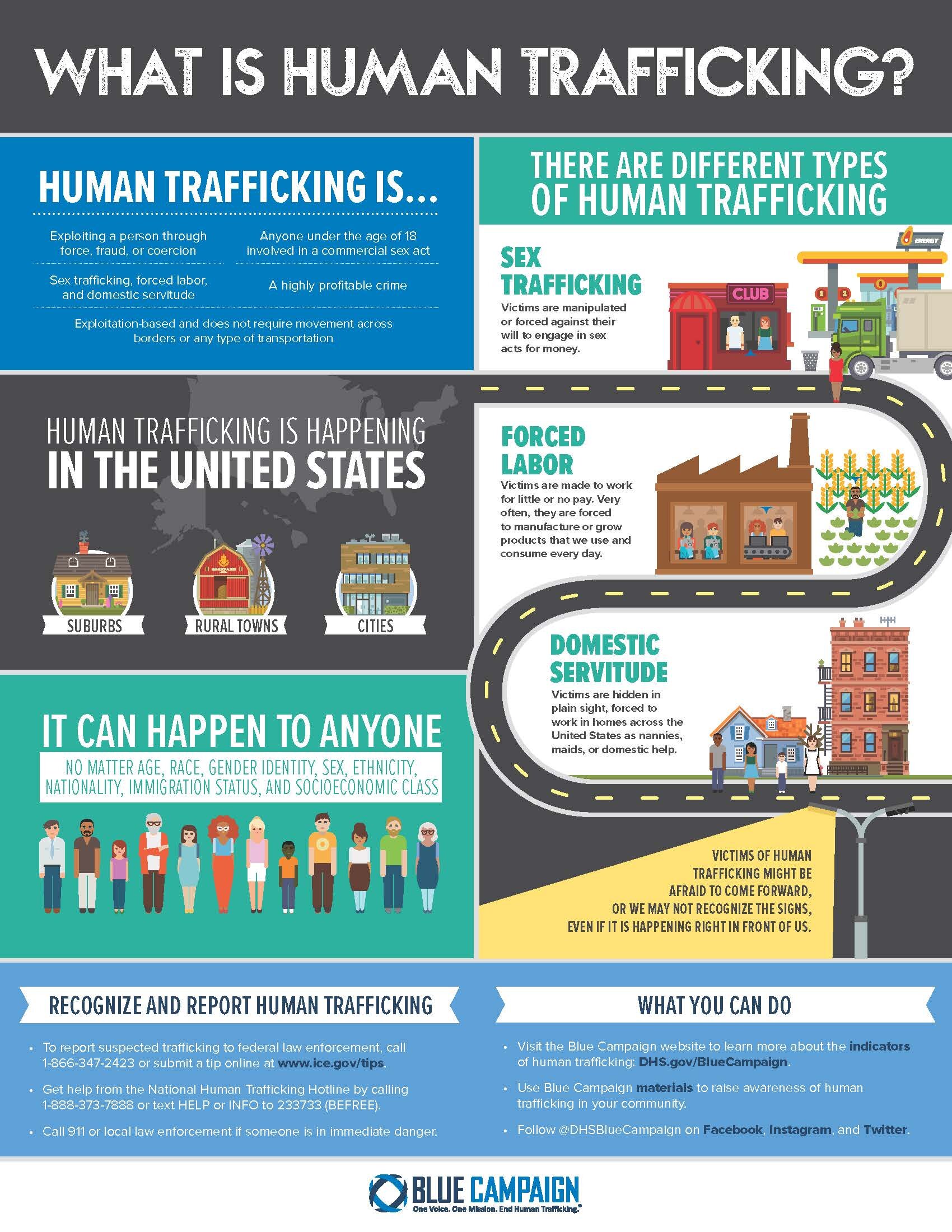Force, fraud, or coercion
U.S. law defines human trafficking as the use of force, fraud, or coercion to compel a person into commercial sex acts or labor or services against his or her will. The one exception involves minors and commercial sex. Inducing a minor into commercial sex is considered human trafficking regardless of the presence of force, fraud or coercion.
Recognizing Sex Trafficking
Sex trafficking occurs when individuals are made to perform commercial sex through the use of force, fraud, or coercion. Any child under 18 who is involved in commercial sex is legally a victim of trafficking, regardless of whether there is a third party involved.
Someone may be experiencing sex trafficking if they:
Want to stop participating in commercial sex but feel scared or unable to leave the situation.
Disclose that they were reluctant to engage in commercial sex but that someone pressured them into it.
Live where they work or are transported by guards between home and workplace.
Have a “pimp” or “manager” in the commercial sex industry.
Have a controlling parent, guardian, romantic partner, or “sponsor” who will not allow them to meet or speak with anyone alone or who monitors their movements, spending, or communications.
Recognizing Labor Trafficking
Labor trafficking includes situations where men, women, and children are forced to work because of debt, immigration status, threats and violence. Keeping victims isolated — physically or emotionally — is a key method of control in most labor trafficking situations. But that does not mean you never cross paths with someone who is experiencing trafficking.
Someone may be experiencing labor trafficking or exploitation if they:
Feel pressured by their employer to stay in a job or situation they want to leave
Owe money to an employer or recruiter or are not being paid what they were promised or are owed
Do not have control of their passport or other identity documents
Are living and working in isolated conditions, largely cut off from interaction with others or support systems
Appear to be monitored by another person when talking or interacting with others
Are being threatened by their boss with deportation or other harm
Are working in dangerous conditions without proper safety gear, training, adequate breaks, or other protections
Are living in dangerous, overcrowded, or inhumane conditions provided by an employer
Myth: It’s always or usually a violent crime
Reality: By far the most pervasive myth about human trafficking is that it always - or often - involves kidnapping or otherwise physically forcing someone into a situation. In reality, most human traffickers use psychological means such as tricking, defrauding, manipulating or threatening victims into providing commercial sex or exploitative labor.
Myth: All human trafficking involves commercial sex
Reality: Human trafficking is the use of force, fraud or coercion to get another person to provide labor or commercial sex. Worldwide, experts believe there are more situations of labor trafficking than of sex trafficking. However, there is much wider awareness of sex trafficking in the United States than of labor trafficking.
Myth: Only undocumented foreign nationals get trafficked in the United States
Reality: Polaris has worked on thousands of cases of trafficking involving foreign national survivors who are legally living and/or working in the United States. These include survivors of both sex and labor trafficking.
Myth: Human trafficking only happens in illegal or underground industries
Reality: Human trafficking cases have been reported and prosecuted in industries including restaurants, cleaning services, construction, factories and more.
Myth: Only women and girls can be victims and survivors of sex trafficking
Reality: One study estimates that as many as half of sex trafficking victims and survivors are male. Advocates believe that percentage may be even higher but that male victims are far less likely to be identified. LGBTQ boys and young men are seen as particularly vulnerable to trafficking.
Myth: Human trafficking involves moving, traveling or transporting a person across state or national borders
Reality: Human trafficking is often confused with human smuggling, which involves illegal border crossings. In fact, the crime of human trafficking does not require any movement whatsoever. Survivors can be recruited and trafficked in their own home towns, even their own homes.
Myth: All commercial sex is human trafficking
Reality: All commercial sex involving a minor is legally considered human trafficking. Commercial sex involving an adult is human trafficking if the person providing commercial sex is doing so against his or her will as a result of force, fraud or coercion.
Myth: If the trafficked person consented to be in their initial situation, then it cannot be human trafficking or against their will because they “knew better”
Reality: Initial consent to commercial sex or a labor setting prior to acts of force, fraud, or coercion (or if the victim is a minor in a sex trafficking situation) is not relevant to the crime, nor is payment.
Myth: People being trafficked are physically unable to leave their situations/locked in/held against their will
Reality: That is sometimes the case. More often, however, people in trafficking situations stay for reasons that are more complicated. Some lack the basic necessities to physically get out - such as transportation or a safe place to live. Some are afraid for their safety. Some have been so effectively manipulated that they do not identify at that point as being under the control of another person.
Myth: Labor trafficking is only or primarily a problem in developing countries
Reality: Labor trafficking occurs in the United States and in other developed countries but is reported at lower rates than sex trafficking.
Myth: Traffickers target victims they don’t know
Reality: Many survivors have been trafficked by romantic partners, including spouses, and by family members, including parents.

